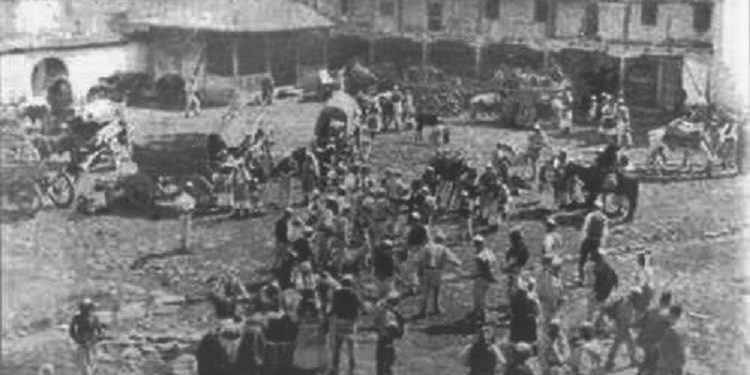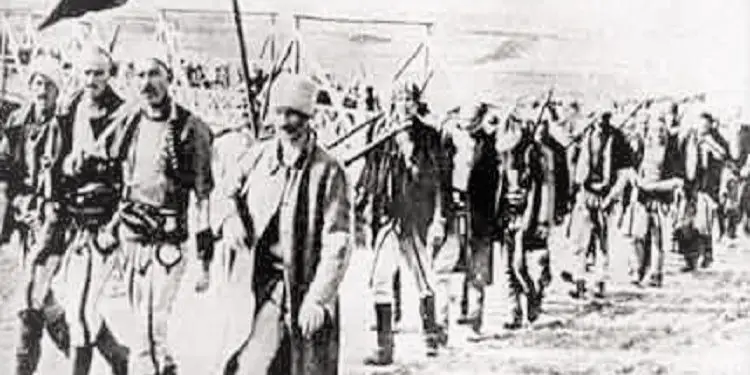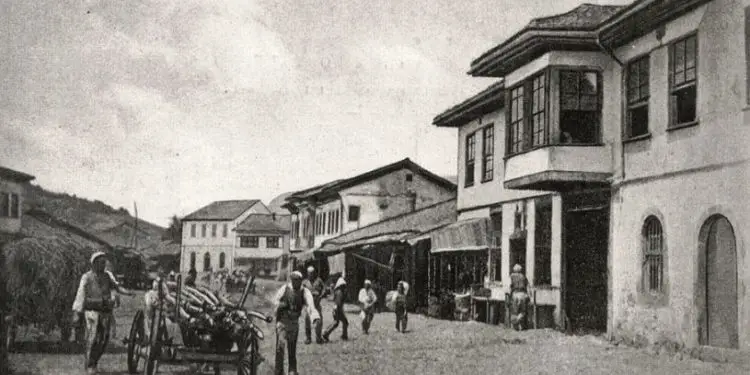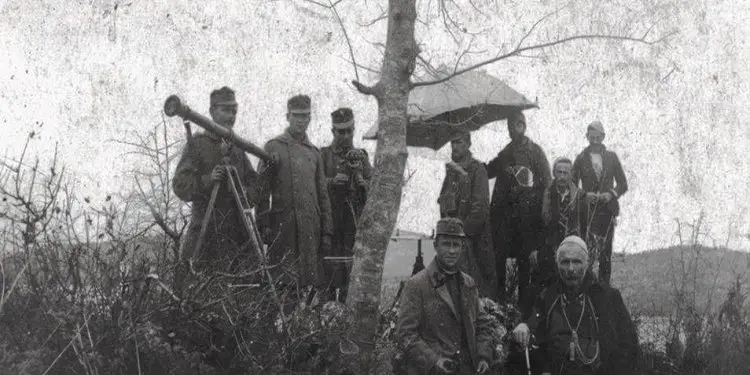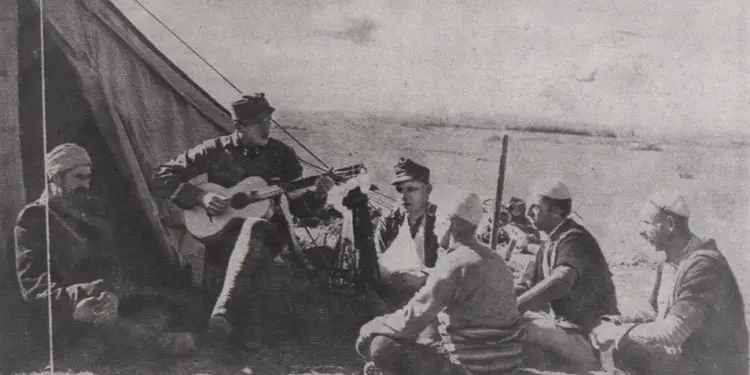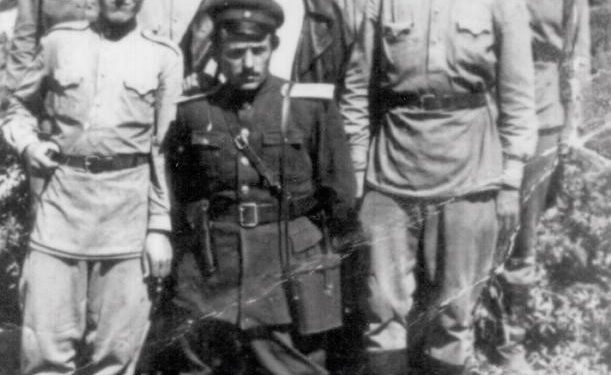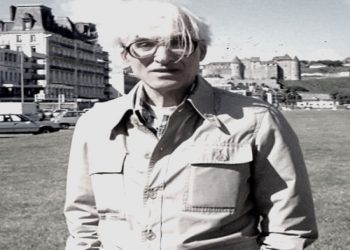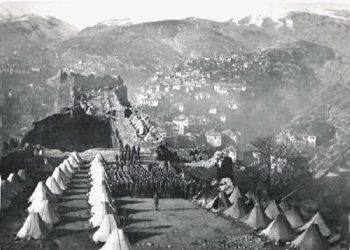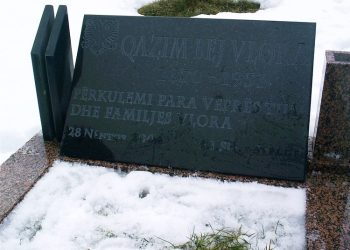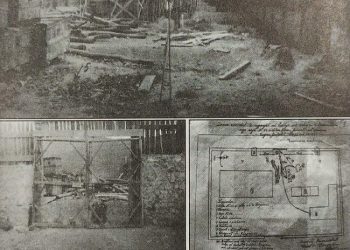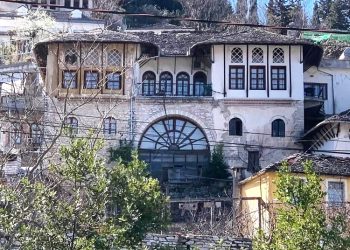From Bashkim Trenova
Part Eighteen
MYTH-MYSTICISM, VICTIMOMANIA, RACISM AND SERBONOSTALGIA
ALBANIANS ACCORDING TO THE SERBS
(THE EASTERN CRISIS AND THE BALKAN WARS)
Memorie.al / “Serbs are descended from the Slavs, a large number of tribes who gave life to the Slavic peoples. Knowledge about the origins of the history of the Slavs is modest and not so clear. Their name appears for the first time in the 6th century AD, when Byzantine writers start talking about the Slavs….”! (Dushan Bataković, Milan St. Protic, Nikola Samardžić, Aleksandër Fotic. History of the Serbian People. L’Age d’Homme. Lausanne. 2005. Pg. 3.)
Continues from last issue
Milivoj Srebro – essayist, literary critic and professor at the Department of Slavic Studies at the University of Bordeaux III:
Indeed, among all the wars that Serbia entered during the 20th century, the First World War was the deadliest, the most tragic. Although at the end of the war, thanks to her great sacrifices and her brave endurance in several memorable battles, she found herself on the winning side, although she was able to achieve her main goal, Serbia came out of this war crushed in flesh and spirit. For her freedom, but also for that of her new compatriots, she sacrificed more than a quarter of her entire population! This sacrifice, which left deep traumas and open wounds that never fully healed, was neither recognized nor could be recognized with the value it deserved by the other Yugoslav peoples. (1)
—
All these questions arise even more strongly when it comes to the treatment of the Serbian exodus through Albania in 1915, this key event of the Great Balkan War, accompanied by a terrible sacrifice with biblical colors, which has remained forever etched in the memory collective under the chilling name “Albanian Golgotha”. That is the reason why we have chosen to place in the center of our reflection this event, in many respects unprecedented, unique in modern Serbian history. (2)
1 – Milivoj Srebro. “Le Golgotha albanais” ou la traversée des enfers. L’écho de la Grande Guerre dans le roman serbe. La Grande Guerre des écrivains. 2016. (“Albanian Golgotha” or the crossing of hells. Echoes of the Great War in the Serbian novel. The Great War of writers). Pg. 682.
2 – Right there. Pg. 683.
—
On November 25, the exodus of an entire people began, because among the exiles, besides the soldiers, there were many refugees, women and children, and the main representatives of the state – the elderly king Peter I, the government, members of the National Assembly. An exodus with biblical colors, a real journey through hell: exhausted and hungry, constantly attacked by armed Albanian gangs, the exiles had to cross for days, sometimes on foot, sometimes on horseback, the impassable mountains Albanian. (1)
—
There were deaths especially in the south of Lezha. The journey ahead will be even more terrifying. According to military data, thousands of refugees and soldiers lost their lives during the forced march from Durres to Vlora. This march was caused by the refusal of the Italian authorities to ensure their rescue through the northern ports of Albania. The last stage of this descent into hell – the rescue of the survivors – will be no less dramatic. (2)
—
The “Albanian Golgotha” was a senseless sacrifice, made in the name of the Yugoslav project adopted, for pragmatic or utopian reasons, by the Serbian political and intellectual elites, who thus acted against their national interests.
But, apart from the political or ideological re-reading of the “Albanian Golgotha”, one thing is certain: for Serbian writers, this key event of the First World War in the Balkans, remains still and always – in terms of its uniqueness in modern national history as well as from its deep imprint on the collective memory – a challenge to be met, a powerful source of inspiration and a subject to ponder over the vicissitudes of the Balkans’ troubled history. (1)
1 – Milivoj Srebro. “Le Golgotha albanais” ou la traversée des enfers. L’écho de la Grande Guerre dans le roman serbe. La Grande Guerre des écrivains. 2016. Pg. 685-686.
2 – Right there. Pg. 687.
****
Milosh Jagodič – Department of History, Faculty of Philosophy in Belgrade:
Not all Albanians had left before the advancing Serbian army….These Albanians stayed at home. A number of Albanian refugees returned to their villages after the end of the ceasefire. Almost all of these people were deported to Turkey after the Congress of Berlin. The new Christian countries, Serbia in this case, did not want to have Muslims on their territory. The Serbian government saw the Albanians as an unwanted and unreliable population that needed to be replaced with a more suitable population. Such a policy was quite common at that time in the Balkans.
Serbian Prime Minister Jovan believed that Serbia should be an ethnically homogeneous country. Moreover, the territories inhabited by Albanians were of strategic importance. They were meant to be the basis for future expansion into Old Serbia and Macedonia. It was therefore necessary to populate them with reliable populations. One of the Serbian generals, Kosta Protic, said then that he did not want Serbia to have its own Caucasus.
The Serbs, on the third day of the war, took Prokupljen.
Muslims in and around the city, mostly Albanians, fled their homes in panic, leaving large quantities of food and livestock behind. The local Albanians fled to the mountain of Pasjaca, south of Prokuplja. Some of these refugees quickly returned to their villages, submitting to the Serbian authorities, while the rest continued to move southwest, towards Kurshumli. During the continuous advance towards Kurshumli, the Serbian troops encountered the Albanian refugees, who were scattered throughout the nearby mountains. As they retreated, they resisted the Serbs and refused to surrender.
1 – Milivoj Srebro. “Le Golgotha albanais” ou la traversée des enfers. L’écho de la Grande Guerre dans le roman serbe. La Grande Guerre des écrivains. 2016. Pg. 709 – 710.
Kurshumlia was captured immediately after Prokuplja. The refugees had already reached the southern slopes of Kopaonik. Turkish forces tried to break into the Toplica Valley to send aid to besieged Nish, so the area around Kurshumli turned into a battlefield. Therefore, the escaped Albanians were forced to stay on the mountain. They expected the Serbs to be expelled from their villages. It turned out that they were waiting in vain. Nishi was taken, the Turks retreated and the refugees did not return home.
After the battles of Gërdelica and in front of Vranje, the Serbs took this city. Many Muslims fled the Vranje area in the following months, after being exposed to all kinds of violence from their Serbian neighbors. The Albanians defended the Veternica canyon, while their families took refuge on the Golak Mountain. Local Serbs took part in the fighting around Veternica. They showed great hostility towards the Albanians by burning their houses, looting and chasing them.
I am unable to describe the emigration of Muslims after the Congress of Berlin, for lack of reliable sources. A small number of them were expelled after the war, the majority left during military operations. Some influential officers took such measures and supported the government measures. Only General Jovan Belimarković opposed the expulsion orders. He did not authorize the departure of Albanians from Masurica. But they were expelled a little later, when the general was on leave. The only compact group of Albanians remained in the Jabllanica valley. In Nis, for example, local administration employees mistreated the remaining Muslims and forced them to emigrate.
After the Congress of Berlin, the situation in the border area was still tense. In June 1879, the Albanians also attacked the city of Kurshumli. The Serbian government protested at the Porta, but its complaints went unanswered.
The arrival of Albanian refugees in Kosovo greatly worsened the situation of the Serbs living there….Albanians were angry because they had lost a war against Serbia. So they took revenge on the Serbs living in Kosovo. The Turkish authorities have been powerless to prevent such behavior, especially during the existence of the “Prizren Connection”. In the years after the Berlin Congress, many Serbs left Kosovo because of the Albanian violence they were exposed to.
Thus, the Serbs who remained in Kosovo were ultimately fewer than the Albanians. Albanians were divided into clans. Some of them were hostile to each other. The idea of a united Albanian nation did not exist among Kosovo Albanians. Their consciousness was tribal. During the war against Serbia, they expressed only local patriotism. After the emigration of Muslims, the new Serbian regions quickly changed their appearance.(1)
****
Milovan Spasic – Doctor of Philosophy, member of the State Council, first librarian of the National Library of Serbia:
These territories in question were populated with a mixed Albanian-Serbian population, while the Albanian element prevailed in the southernmost areas. Thus, in the Toplica District alone, before the Serbo-Ottoman wars, there were more than 246 pure Albanian villages, but there may have been even more, claims another Serbian author, who had visited several villages since 1877. 2)
1 – Milosh Jagodic. “The Emigration of Muslims from the New Serbian Regions 1877/1878”. (Emigration of Muslims from the new Serbian regions 1877/1878). Balkanology. Vol. II, no. 2/1998.
2 – Milovan Spasic, Data on agrarian relations čristana u oslobodenim kraje-vima okruga topličkog i vranjskog za vreme turske rujajna. (Data on agrarian relations with Christians during the Turkish rule in the liberated villages of the district of Toplica and Vranje). “Glasnik Srpskog učenog društva, LXXI, Belgrade 1890. Pg. 235-243.
****
Momir Turudič – journalist:
Albanians live in the Balkans, apart from Albania and Kosovo, also in Serbia, Macedonia, Greece and Montenegro. If we had to describe in a few words the common condition of the inhabitants of this area, we would have such a picture: anger, dissatisfaction, lack of hope for a better future. In such an atmosphere, the stories of “age-old enemies”, mainly neighbors, references to “our glorious past” and “their crimes”, are received by most rather better than visions of a common future. (1)
****
R. Markovic:
At the beginning of 1912 there was a major uprising. The Albanians rose against the Turks, occupied Kosovo, Northern Albania, and Skopje and reached Thessaloniki. The Porte had to promise them autonomy, which included the four provinces mentioned. In preparation for its war against the Turks, Serbia approached Albanian leaders in an attempt to win them over to its side. …but the Albanians still believed that their territories would be endangered by the Balkan states, so they refused to cooperate and decided to side with Turkey in the next war.
Kosovo Albanians welcomed the Serbian army as an invader that destroyed the dream of an “autonomous Albania”. During the fierce fighting, many places were razed, such as Ferizovici, which was called Ferizaj. Mass reprisals were carried out against the civilian population.
The Serbs continued their advance towards the Adriatic Sea; in some parts of Albania they were received as liberators, in others as invaders. The Serbian army occupied most of today’s Albania and the most important strategic point, the port of Durrës, and withdrew from Albania only at the end of 1913, under pressure from the great powers.
During its campaign, the Serbian army committed numerous mass crimes against the Albanian civilian population, as written by Kosta Novakovic, a Serbian socialist politician and journalist who participated in the military campaign in Albania, and Dimitrije Tucovic in his book “Serbia and Albania”, where criticizes the invading policy of the Serbian bourgeoisie towards Albania and the crimes against Albanians during the Balkan wars. The Balkan wars are mentioned among the most tragic events in the history of Albania.
On the other hand, Serbian history marks the “Albanian Golgotha”, when during the First World War before the Austro-Hungarian-German offensive against Serbia, at the end of 1915; the Serbian army with 200 thousand refugees began to withdraw through Albania towards the sea. It is often emphasized that in addition to the winter and famine, the Serbian refugees and the army were destroyed by the Albanian detachments, which attacked them (there is less talk about cases of help from the local population). (1)
—-
1 – Momir Turudic. Weather N. 1242. 23/10/2014.
****
Trisha Kaclerovic – journalist, lawyer and politician:
When the Albanian people tried to protect themselves from the new captivity (previously they were under Turkish captivity) – then the Serbian army carried out unprecedented massacres on the Albanian people, they killed and cut them – yes, they practically slaughtered them, to save ammunition – with tens of thousands of people: old and young, men and women, and they leveled dozens of Albanian villages and settlements with fire. And all this was done by a small state to an even smaller people, who after the fall of the Turkish Empire wanted to create their own independent state. This is how little capitalist Serbia acted, not popular Serbia, which only two months ago had ended the war with Turkey, to free its captive people. And, when Austro-Hungarian and German imperialism attacked Serbia in 1914 and occupied it, then Serbia screamed and alarmed the whole world, but on this occasion it forgot that it acted equally with the Albanian people, fighting against foreign imperialism, but applied its imperialism to those smaller and weaker than itself. (1)
1 – R. Markovic. What are you doing in Albania – Serbian-Albanian relations? (What is Albania for you-Serbo-Albanian relations). Vreme, N.1242. 23/10/2014.
****
Slavenko Terzic – historian, member of the Serbian Academy of Sciences and Arts:
The RVA army crossed the border on October 20, halted in front of Kumanovo to rest and awaits the arrival of the 3rd Army, which was to penetrate the Vardar Valley, near Skopje, through the Kaçanik gorge. She did not come, because of the border fighting in Kosovo and Metohija.
The mood of the army and the atmosphere of the night before the battle is described by Branislav Pantic, then sergeant of the 4th company of the 3rd battalion of the 18th regiment, in the article: “Eighteenth infantry regiment in the battle of Kumanovo: Our mood was also the same with this good weather and with the successes achieved so far, so that the evening of October 22 was spent full of pleasure, with laughter induced by various jokes about the Turks.
In a word, it was an evening that in no way foreshadowed the chaos and destruction of tomorrow, when all our youthful illusions and fantasies about the triumphant entry into Dushanbe Skopje were almost shattered, shattered and thrown away in eternity. We are not mentioning the possibility of defeat, which was so close and seemed completely impossible to us that evening.
In accordance with the war plan and the order of the High Command of November 3, as well as with the government’s policy to enter Albania and reach the Adriatic Sea, at the beginning of November 1912, the troops of Drin were trained by the Third Army and of the Multitude. Army Commander Jankovic asked the High Command to postpone the movement in this direction “because there is no bread, there is no fodder, there is no…”, but he was told to leave as soon as possible, to break through rapidly in Albania to the Adriatic Sea, in order to prevent in this way an intervention of great powers, which were practically put before the fact. In fierce fighting across Albania from 8 to 29 November, Serbian forces managed to take control of the central and northern Albanian coasts, capturing Lezha, Kruja, Tirana and Durrës.
1 – Trisha Kaclerovic, “Berner Tagwacht”, Bern, Switzerland. May 1916. See also Abdulla Mehmeti. Why all this internationalism, cosmopolitanism and globalism among Albanians?
The news. 13. 05. 2020.
Fighting in the territory of Albania with Turkish troops and Albanian irregular forces, until yesterday loyal allies of Turkey, continued during the first months of 1913. In November 1912, the Serbian army in Albania was still operating in the territory of the Turkish state. With the fall of Ioannina on March 6, Jedrena on March 26 and Shkodra on April 23, 1913, the military operations of the First Balkan War practically ended. In Vlora, on November 28, 1912, the same day when Serbian troops entered Tirana and Durrës, an independent Albania was proclaimed, which significantly changed the military-political situation. With the intervention of major powers, primarily Austria-Hungary, in April 1913, the withdrawal of Serbian troops from Albania began. (1)
****
Vaso Čubrilović – politician, professor of the University of Belgrade, minister and member of the Serbian Academy of Sciences and Arts:
The clearing of the area around Toplica and Kosanica by the Arnauts in 1877 and 1878 was probably not carried out according to a plan from above, it was rather instinctive, but radical, during wars and operations. That the Albanians of these provinces moved voluntarily and were not deliberately expelled by force, this can be seen quite well from the operations of the Serbian army in these provinces in 1877 and 1878. As soon as the first Serbian units began to penetrate towards Kurshumli, Prokuplje and Leskovci, they met in dense concentration of Albanians, who did not want to surrender.
The main fight against them was to be done by the Serbs. One village after another had to be conquered. The Arnauts drew the population unfit for war to the south, secured them in shelters and continued the war. When the Serbian army approached the shelters, they retreated through the valleys of South Morava, Veternica, Medvegja, Pusta Reka, Llap and further into Kosovo. Thus, with the gradual penetration of the Serbian detachments, Toplica was cleared of Arnauts. They left Kurshumli in the first battles around it in December 1877. Prokuplja was emptied without a fight. Not infrequently, the Arnauts, as in the village of Krivak, hit the Serbian detachments on the way; then the wards had to be sent to clear the village of them. Timok’s corps, marching through the “arnaut” in Toplica towards Kosovo, encountered such a strong resistance of the Arnauts that he had to slow down the advance to clear the rear of them.
Some Arnauts surrendered and returned to the villages from Mount Gollak. The Kragujevac brigade left garrisons in the villages of Vllas, Oshtra, Glava and in Lalinca to guard them. The surrender of Arnaut villagers on the right side of Morava around Surdulica, Zhitorade, Prekodollci, Llugojnice etc. was also accepted. Few Albanians remained under Mount Gollak even after the peace achieved.
The Muslim population for the most part abandoned the cities of Nish, Ak-Pallank, Pirot, Leskovc and Vranje during the war. It was mainly settled in Old Serbia.
1 – Slavenko Terzic: Oslobodenje Stare Serbia 1912 building. (Liberation of Old Serbia in 1912). Nemanja. 27. 03. 2013. P. 7-8.
After being pushed from the area between South Moravia and Kopaonik, in 1877-1878, the Arnauts settled immediately near the new Serbian border. They flocked to the Llap Valley and Kosovo, especially around Pristina where, retreating through the Medvegja valley, they gathered more displaced people from the regions that had been occupied by the Serbs. According to Cvijič, around 30,000 people moved from Serbia then. Thus, the Albanian population in Kosovo became very dense.
After 1878 Serbia had to colonize the regions left by Arnauts and Turks. The border villages with Kosovo had to be populated as soon as possible with safe national population to guarantee the border with Arnauts.
The process of moving the Turks remaining in the cities and populating the empty Albanian villages was done faster than thought… It didn’t even take 30 years that in the wars of 1912-1913, Toplica, the most notorious settlement in 1877, gave Serbia the second, best regiment. (1)
—
It is impossible to expel Albanians only through gradual colonization; he is the only people who have managed during our thousand-year journey not only to resist the core of our state, Rashka and Zeta, but also to have caused us damage, pushing our ethnic borders to the north and east. And, while during the last millennium, our ethnic borders have moved north to Subotica, and north-east to Kupa, the Albanians have expelled us from the region of Shkodra, the former capital of Bodin, from Metohija and from Kosovo. The only way and the only means to drive them out is the brute force of an organized state, in whose bosom we have always dominated. (2)
—
There remains a tool that Serbia has used in a very practical way after 1878, the secret burning of Arnaut villages and neighborhoods in cities. (3) Memorie.al
1 – Vaso Cubrilovic. Odabrani historical works. (Selected historical works). Pg. 540-543. Belgrade 1983, “Narodna Knjiga”.
2 – Vaso Cubrilovic. From the speech held on March 7, 1937 at a Conference of the SKK (Serbian Cultural Club). Balkanology. Vol. XII, No. 1/ 2010.
3 – Vaso Cubrilovic. Speech delivered on March 7, 1937 at the Culture Club in Belgrade. “Mladina” no. 49. 1988. Page 3.
Next issue follows





